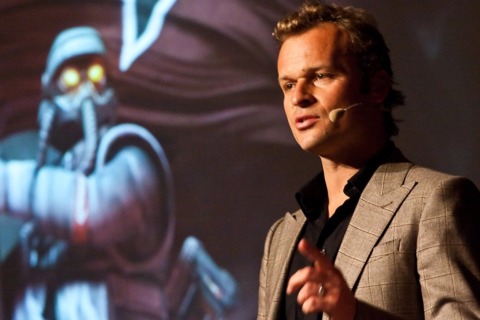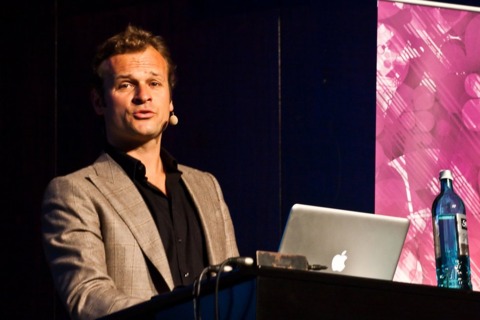Guerrilla Games talks rocky starts, confirms new IP
GDC Europe 2010: Hermen Hulst describes 10-year history of Killzone, that E3 2005 trailer, and where the studio is headed.
Who was there: Hermen Hulst, managing director of Guerrilla Games.

What he talked about: In a panel titled "Bottled Lightning: Game Development Guerrilla Style," Hulst led the audience on a whirlwind tour through the highs and lows of his studio's decade-long history. The main thrust of his presentation was that every studio, more than anything else, needs to constantly improve itself to survive. Hulst spoke at length about the ambitious nature of Guerrilla, how it led to trouble early on, and how they were able to more effectively channel that ambition in order to make last year's critically acclaimed Killzone 2.
Hulst led off the discussion with a look at a pitch demo, first shown to Sony in December 1999, for what would become the original Killzone. The video was simply titled "Marines" and showed a number of plain soldiers running through a warzone with abundant sound effects and explosions. The video was intended to show the technology the studio was capable of, and it lacked any of the familiar Helghast enemies that the Killzone series would eventually become associated with. Sony nonetheless took the bait, which left the Amsterdam-based Guerrilla with the daunting task of actually creating a game out of that pitch demo.
The process of developing Killzone was very much a learning process for the upstart studio. Certain decisions that Guerrilla made in those early days are ones that Hulst said still pay off today. One was the decision to create a custom game engine from scratch rather than go with an off-the-shelf solution such as Unreal. To Hulst, the engine has become part of Killzone's DNA, and a studio is at its best when it's free from being limited by someone else's technology, he said. Studios that use their own engines, Hulst claimed, are the ones best capable of making truly unique experiences because the technology and design grow alongside one another.
The other early decision that Hulst looked back on with fondness was the process of developing a memorable enemy over a hero. This creative choice led them to Killzone's Helghast race, which were designed from the start to resemble futuristic versions of Nazi soldiers in order to mix the new and exotic with the iconic and familiar. Hulst poked some fun at his studio's work, admitting that the game really just boiled down to "space Nazis versus space good guys," but the vivid image of the Helghast soldier is one that the series has become closely associated with, and it has led to an instant visual iconography that not a lot of games have.
However, Killzone didn't live up to expectations, and much of that was thanks to Guerrilla's unchecked ambition in those early days. Hulst described the development team as unguided but highly energetic, lacking professional leadership and proper structure to guide their vision. A few examples of that chaos: For a long time at the beginning of Killzone's development, Guerrilla didn't employ a single game designer. Only artists and programmers were building the game world, with no regard for how it would actually play. Later on in development, an overzealous technical decision left the game engine broken for several straight months, leaving the artists to come up with visual assets that they had to insert into the game with absolutely no idea how they would look in action.
Killzone ultimately accrued a 70 rating on GameSpot sister site Metacritic, and at first it seemed as if Guerrilla had bitten off more than it could chew again with the PSP offshoot Killzone: Liberation. Sony pitched it to the studio as a "showcase title" for its new portable, and Guerrilla simply couldn't turn down the allure of such a project. But Hulst said the studio managed to take some steps forward with Liberation, organizing the studio with a game director in charge of the overall quality and producers who would help make sure the game shipped on time. Add to that more of a focus on game design at the beginning of the project, and the result was a game that reached 77 on Metacritic. Hulst admitted this wasn't a tremendous leap forward, but it still showed a pleasing "upper trend."

It wouldn't be until Killzone 2 that Guerrilla made that big jump forward with the quality of its games. Killzone 2 was originally developed as a PlayStation 2 title with a Christmas 2006 release date, but plans were changed early on when Sony decided to invest more in the studio and put it to work on developing a PlayStation 3 title. The original version of Killzone 2 was scrapped, and the team got to work on the Killzone 2 that sits in stores today.
Keeping up with earlier themes, there were some difficulties faced along the way. According to Hulst, the infamous E3 2005 trailer for Killzone 2--the one with the prerendered graphics intended to show what the final game would be capable of looking like--was created with the intention of being shown in small, behind-closed-doors settings to select members of the press. But Hulst said Sony showed so much confidence in the trailer that it wanted to air it to the entire gaming world at its press conference, and Guerrilla, being an ambitious studio, was proud to see its work on the big stage.
What came out of airing that trailer, according to Hulst, was both "a blessing and a burden." The burden was that, to a lot of people, the studio's reputation was smeared, they were regarded as liars, and they would have to work to recover Guerrilla's good name. The blessing was that now the studio had a lofty goal in place with no room for excuses. "Uh-oh, we're now going to have to make this, right?" Hulst joked.
The biggest problem was that the trailer was developed before they really got to work on the actual game. "Try to avoid announcing a game before you start doing any work on it," Hulst joked. That left them in an eerily similar position to the original Killzone: There was essentially an ambitious pitch video, but no game or engine to support it. So the team got to work on what is now Killzone 2, knowing this time that there would have to be a better organization and process in place if they wanted to improve that upward trajectory in quality that Liberation established.
Among the examples Hulst showed off, Guerrilla's new, more professional approach to game design was an almost obsessive-compulsive spreadsheet of Killzone reviews that took every point made about the game, broke them up into different categories, and assigned a numeric score based on the reviewer's opinions. The idea was to take the five best-received features of Killzone and do more of that, but also--and this was the hard part--take the five worst-reviewed parts of the game and instead of cut them out, turn them into the best parts of Killzone 2. Hulst cited enemy AI, death animations, and multiplayer as some of the parts of Killzone that reviewers panned the most, only to become among the most highly praised features of its sequel. To Hulst, this "bottom-up" approach was among the biggest reasons for Killzone 2 landing a 91 average on Metacritic.
After that game shipped, Hulst said that the studio still needed to improve. That's why instead of giving themselves another three-and-a-half-year development cycle like Killzone 2 had, they would release Killzone 3 in two years. Hulst described this as essentially putting their creativity in a pressure cooker, but a natural step for a studio that has managed to make itself more streamlined and efficient with every subsequent game. Echoing the title of his presentation, Hulst said that transformation has been like putting lightning in a bottle. The drive and ambition that got the studio into so much trouble early on has now been successfully contained, he said.

Interestingly, Hulst didn't stop at Killzone 3 when talking about the studio's upcoming work. He confirmed that the studio is indeed beginning to work on a new intellectual property. No details were provided, but he did make sure to point out that this next project is not a Killzone title.
Quote: In reference to how the studio has maintained its own quirky corporate culture after the Sony acquisition, Hulst said, "We are by any and all measures Guerrilla Games, and not Sony Amsterdam." This was accompanied by talk of water coolers filled with sangria, "Friday Fragfests," and impromptu mustache-growing competitions.
Takeaway: Guerrilla is a studio that has come a long way in 10 years, but that transformation hasn't always been an easy one.
Sclash - Console Release Date Trailer Kingdom Come: Deliverance 2 - Official Cinematic Announcement Trailer Stellar Blade - BIBI ‘Eve’ Official Music Video Trailer | PS5 Apex Legends: Urban Assault Collection Event Trailer Total War: WARHAMMER III - Elspeth von Draken Gameplay Showcase Genshin Impact - "Arlecchino: Sleep in Peace" | Official Character Teaser Minecraft – Kung Fu Panda DLC Trailer Potionomics: Masterwork Edition - Official Announcement Trailer Snowbreak: Containment Zone - "Gradient of Souls" Version Trailer Harold Halibut GameSpot Video Review Nancy Drew: Mystery of the Seven Keys | World Premiere Official Trailer Modern Warfare III & Warzone - Official Cheech & Chong Bundle Gameplay Trailer
Please enter your date of birth to view this video
By clicking 'enter', you agree to GameSpot's
Terms of Use and Privacy Policy
Got a news tip or want to contact us directly? Email news@gamespot.com
Join the conversation